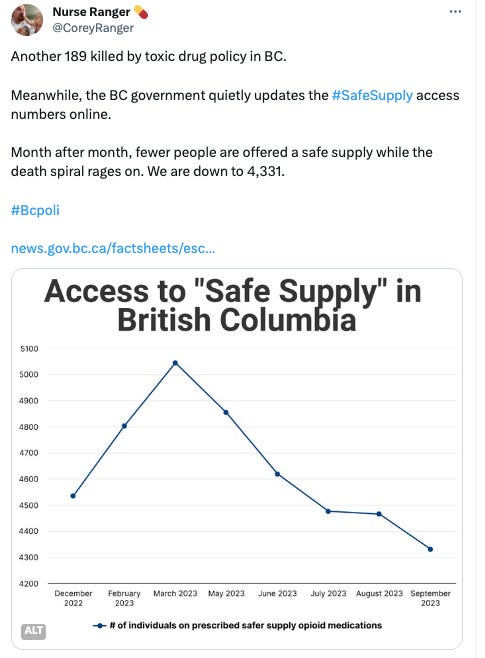Recovering from a common misconception
Yet another study showing detox and residential treatment do not reduce drug poisoning should prompt an international policy shift.

A new study indicates that abstinence-based inpatient addiction treatment fails to reduce drug poisoning risk. Even worse: abstinence-oriented treatment may be associated with higher rates of opioid poisoning than no treatment at all.
The Connecticut study analyzed 965 opioid poisoning deaths from 2016-17, the approximate moment fentanyl hit the illegal market there. The deceased people had recently undergone one of several conditions: no treatment, medication-based (buprenorphine or methadone) treatment or short-term (<14 days—essentially referring to detox) or long-term (>21 days) addiction treatment in which medication was not provided. The study reinforced previous findings that “meds, not beds” is the evidence-based approach to reduce opioid poisoning risk.
This does not mean abstinence does not work for some people or that inpatient options should not be made available, but we need to be more scrupulous about Mental Health & Addiction budgets—for example Alberta’s, which designates hundreds of millions in capital and operating expenses for each of the next three years to build and run privately operated addiction facilities.
In a political climate where governments seem content with appearing to do something—anything—about drug poisoning, advocating for expanded residential treatment and detox despite their inability to reduce death rates while the Alberta government continues to flirt with forced abstinence could be actively causing harm.
In Alberta, we spend at least 10-fold more on residential treatment than we do on supervised consumption. This gap is only widening as the UCP continues to defund harm reduction in favour of institutionalizing people who use drugs, while finding new ways to convey their message to their designated stakeholders. In April 2024, Calgary will be treated to another provincially funded Recovery Capital Conference, the recovery industry’s central propaganda and deal-striking forum.
(As an experiment, try searching any right-wing politician’s twitter handle with the word “recovery,” which has been hijacked as a stand-in for “abstinence.” You might be surprised by how much rent it commands. Here’s a starting point with AB Premier Danielle Smith.)
BC is hardly better, with its Minister of Mental Health & Addiction tallying the province’s 3,200 treatment beds—2.5-fold more than Alberta—while contributing its own sponsorship dollars to this fall’s Recovery Capital tour.
It’s agonizing to watch the BC government tie itself in knots to avoid making correct drug policy decisions. Safe supply prescribing is now ebbing, having only ever reached a tiny fraction of people at risk of poisoning, and the province’s short-lived experiment with decriminalization has been rolled back after continued pressure from police and their political allies. (Starting today, this is being challenged in court by the Harm Reduction Nurses Association represented by Pivot Legal.)

Alberta and BC lead all other provinces in drug poisoning death rate. Despite the lip service paid to harm reduction in BC, its budget remains fundamentally abstinence-oriented. Meanwhile, Alberta has abandoned lip service altogether, emphasizing through repeated political overtures its focus on its ‘recovery-oriented’ system of care. Why would any province follow these failed jurisdictions?
It’s not far-fetched to imagine either of these governments rolling out a sweeping new public hand sanitizer program to address COVID, while ignoring clean air. Drug poisoning is no different: we continue making room for politicians, media, and even many advocates to misdiagnose and mistreat the biggest killer of young people in this country since World War II.
Reinforcing the recent study on abstinence-based inpatient treatment, a sweeping 2020 study of over 40,000 people diagnosed with opioid use disorder in the US found that of six assessed treatments, only outpatient buprenorphine or methadone treatment protected against overdose or downstream opioid-related acute care. The other ‘treatments’ (inpatient detox or residential treatment, outpatient medication-assisted with naltrexone, inpatient counselling, outpatient counselling, or no treatment) showed no statistically significant effect.
When I brought this up with Alberta’s Ministry of Mental Health and Addiction, they responded that this 2020 study doesn’t reflect the ‘Alberta model,’ which provides rapid access to medications and integrates these into residential treatment facilities (it doesn’t, actually—around 40% of residential treatment spaces and 40% of detox spaces restrict various medications, and benzodiazepine withdrawal is a whole other story).
Regardless of the integration of medications into these inpatient programs, if outpatient medication programs provide the same or better outcomes, why are we building so many “recovery communities”?
If you are conducting advocacy on drug policy, you should be well versed on five critical research findings of 2023. If you are not, I implore you to follow the links below and consider how they align with what you are saying publicly.
- Abstinence-based addiction treatment does not reduce drug poisoning risk, and could create higher risk than no treatment.
- Drug confiscation by police is followed by heightened drug poisoning in a 500m radius around the bust for weeks following.
- Safe supply reduces drug poisoning and petty crime among those enrolled.
- Encampment evictions increase drug poisoning risk for people who inject drugs.
- Overdose prevention sites and syringe service programs are not associated with higher crime.
We continue to see right-wing advocates moving the goal posts on these discussions. Adam Zivo has adopted this role at National Post Opinion, for example by reformulating criticism of seemingly profiteering physicians into victim narratives. To these folks, it doesn’t matter if their arguments are rooted in evidence: the point is to delay expansion and implementation of badly needed programs and services, to buy enough time to elect a more harm reduction-hostile federal government before the broken pendulum of drug prohibition is tossed in the waste bin of history.
Many of these advocates also recognize the imminent possibility of the mainstream public waking up to the golden opportunity to reallocate municipal, provincial and federal budgets from police and border militarization to social safety nets that have been decimated over the last generation.
However, the continued incrementalism of even progressive-speaking governments tells us that those in power are not interested in these outcomes.
There are good reasons people call for expanded abstinence-based services, despite the abundant evidence supporting alternative pathways. For many, abstinence worked for them (often after multiple attempts), and they want the same access provided more easily for people. Many parents are at their wits’ end with youth who use drugs and turn to the only solution on offer: residential treatment. Quite often, I hear from people exhausted after giving up their living rooms to unhoused friends or family members. Inpatient and sober living facilities offer temporary housing for those willing to pause—or hide—their drug use.
This may be the crux: having failed to address the housing crisis, governments pass the buck to individuals, who are provided few options beyond privatized addiction facilities to temporarily house their loved ones.
Data on factors informing success rates of residential treatment and detox are not publicly disclosed by any province in Canada that I could find, but this forms part of the basis for various Housing First models. For those who use drugs to endure hard living conditions (such as houselessness or ongoing abuse), institutionalization is unlikely to solve anything. Conversely, someone who has their basic needs met and is looking to stop using drugs might just need a short, supported break to achieve lasting abstinence.
There is a real societal tendency to warehouse people rather than support them in their lives as they exist—as clear an example of stigma as you can find. There is also an emerging strain of paternalism that insists stigma can solve drug poisoning. National Post Opinion continues to adopt this point, which was propagated at Alberta’s safe supply committee by Michael Shellenberger echoing the chief of staff to the Alberta premier, Marshall Smith.

To insist people who use drugs must be saved from themselves while public budgets tell them their lives aren't worth saving is whiteness in living colour.





